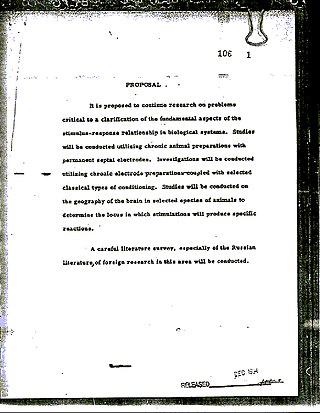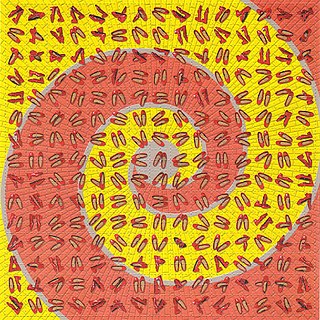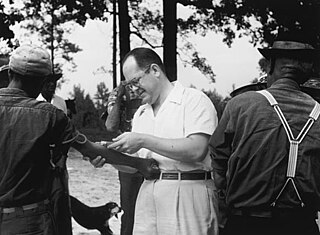
"Truth serum" is a colloquial name for any of a range of psychoactive drugs used in an effort to obtain information from subjects who are unable or unwilling to provide it otherwise. These include ethanol, scopolamine, 3-quinuclidinyl benzilate, midazolam, flunitrazepam, sodium thiopental, and amobarbital, among others.

Project MKUltra was a human experimentation program designed and undertaken by the U.S. Central Intelligence Agency (CIA) to develop procedures and identify drugs that could be used during interrogations to weaken individuals and force confessions through brainwashing and psychological torture. The term MKUltra is a CIA cryptonym: "MK" is an arbitrary prefix standing for the Office of Technical Service and "Ultra" is an arbitrary word out of a dictionary to denominate this project.
Incapacitating agent is a chemical or biological agent which renders a person unable to harm themselves or others, regardless of consciousness.

Frank Rudolph Emmanuel Olson was an American bacteriologist, biological warfare scientist, and an employee of the United States Army Biological Warfare Laboratories (USBWL) who worked at Camp Detrick in Maryland. At a meeting in rural Maryland, he was covertly dosed with LSD by his colleague Sidney Gottlieb and, nine days later, plunged to his death from the window of the Hotel Statler in New York. The U.S. government first described his death as a suicide, and then as misadventure, while others allege murder. The Rockefeller Commission report on the CIA in 1975 acknowledged their having conducted covert drug studies on fellow agents. Olson's death is one of the most mysterious outcomes of the CIA mind control project MKUltra.
Sidney Gottlieb was an American chemist and spymaster who headed the Central Intelligence Agency's 1950s and 1960s assassination attempts and mind-control program, known as Project MKUltra.
Project Artichoke was a project developed and enacted by the United States Central Intelligence Agency (CIA) for the purpose of researching methods of interrogation. Project Artichoke was succeeded by Project MKUltra, which began in 1953.

MKNAOMI is the code name for a joint Department of Defense/CIA research program from the 1950s through to the 1970s. Unclassified information about the MKNAOMI program and the related Special Operations Division is scarce. It is generally reported to be a successor to the MKULTRA project focusing on biological projects including biological warfare agents—specifically, to store materials that could either incapacitate or kill a test subject and to develop devices for the diffusion of such materials.

The psychedelic drug lysergic acid diethylamide (LSD) was first synthesized on November 16, 1938, by the Swiss chemist Albert Hofmann in the Sandoz laboratories in Basel, Switzerland. It was not until five years later on April 19, 1943, that the psychedelic properties were found. Today, the discovery of LSD is celebrated worldwide during the annual Bicycle Day holiday, serving also as the day celebrating the psychedelic revolution in general.
Louis Jolyon West was an American psychiatrist involved in the public sphere, known mainly for his work/involvement with the MKUltra project, a CIA mind control project in the late 1960s.
Pharmacological torture is the use of psychotropic or other drugs to punish or extract information from a person. The aim is to force compliance by causing distress, which could be in the form of pain, anxiety, psychological disturbance, immobilization, or disorientation.
Operation Midnight Climax was an operation carried out by the CIA as a sub-project of Project MKUltra, the mind-control research program that began in the 1950s. It was initially established in 1954 by Sidney Gottlieb and placed under the direction of the Federal Bureau of Narcotics in Boston, Massachusetts with the "Federal Narcotics Agent and CIA consultant" George Hunter White under the pseudonym of Morgan Hall. Dr. Sidney Gottlieb was a chemist who was chief of the Chemical Division of the Office of Technical Service of the CIA. Gottlieb based his plan for Project MKUltra and Operation Midnight Climax off interrogation method research under Project Artichoke. Unlike Project Artichoke, Operation Midnight Climax gave Gottlieb permission to test drugs on unknowing citizens, which made way for the legacy of this operation. Hundreds of federal agents, field operatives, and scientists worked on these programs before they were shut down in the 1960s.

From 1948 to 1975, the U.S. Army Chemical Corps conducted classified human subject research at the Edgewood Arsenal facility in Maryland. These experiments began after the conclusion of World War II, and continued until the public became aware of the experiments, resulting in significant outcry. The purpose was to evaluate the impact of low-dose chemical warfare agents on military personnel and to test protective clothing, pharmaceuticals, and vaccines. A small portion of these studies were directed at psychochemical warfare; grouped under the title "Medical Research Volunteer Program" (1956–1975), driven by intelligence requirements and the need for new and more effective interrogation techniques.
Camp King is a site on the outskirts of Oberursel, Taunus, with a long history. It began as a school for agriculture under the auspices of the University of Frankfurt. During World War II, the lower fields became an interrogation center for the German Air Force. After World War II, the United States Army also used it as an interrogation center and intelligence post. The United States CIA used the site to test drugs including LSD on prisoners as part of Project BLUEBIRD, the predecessor to MKUltra. In 1968, it became the command and control center for the United States Army Movements Control Agency - Europe (USAMCAEUR). Today it has been rebuilt as a German housing area.
United States v. Stanley, 483 U.S. 669 (1987), was a United States Supreme Court case in which the Court held that a serviceman could not file a tort action against the federal government even though the government secretly administered doses of LSD to him as part of an experimental program, because his injuries were found by the lower court to be service-related.

Psychochemical warfare involves the use of psychopharmacological agents with the intention of incapacitating an adversary through the temporary induction of hallucinations or delirium. These agents, often called "drug weapons", are generally considered chemical weapons and, more narrowly, constitute a specific type of incapacitating agent.
Throughout history, prisoners have been frequent participants in scientific, medical and social human subject research. Some of the research involving prisoners has been exploitative and cruel. Many of the modern protections for human subjects evolved in response to the abuses in prisoner research. Research involving prisoners is still conducted today, but prisoners are now one of the most highly protected groups of human subjects

Numerous experiments which were performed on human test subjects in the United States in the past are now considered to have been unethical, because they were performed without the knowledge or informed consent of the test subjects. Such tests have been performed throughout American history, but have become significantly less frequent with the advent and adoption of various safeguarding efforts. Despite these safeguards, unethical experimentation involving human subjects is still occasionally uncovered.

Acid Dreams: The Complete Social History of LSD: the CIA, the Sixties, and Beyond, originally released as Acid Dreams: The CIA, LSD, and the Sixties Rebellion, is a 1985 book by Martin A. Lee and Bruce Shlain, in which the authors document the 40-year social history of lysergic acid diethylamide (LSD), beginning with its synthesis by Albert Hofmann of Sandoz Pharmaceuticals in 1938. During the Cold War period of the early 1950s, LSD was tested as an experimental truth drug for interrogation by the United States intelligence and military community. Psychiatrists also used it to treat depression and schizophrenia. Under the direction of Sidney Gottlieb, the drug was used by the Central Intelligence Agency (CIA) in cooperation with participating "colleges, universities, research foundations, hospitals, clinics, and penal institutions". LSD was tested on "prisoners, mental patients, volunteers, and unsuspecting human subjects".
Unethical human experimentation is human experimentation that violates the principles of medical ethics. Such practices have included denying patients the right to informed consent, using pseudoscientific frameworks such as race science, and torturing people under the guise of research. Around World War II, Imperial Japan and Nazi Germany carried out brutal experiments on prisoners and civilians through groups like Unit 731 or individuals like Josef Mengele; the Nuremberg Code was developed after the war in response to the Nazi experiments. Countries have carried out brutal experiments on marginalized populations. Examples include American abuses during Project MKUltra and the Tuskegee syphilis experiments, and the mistreatment of indigenous populations in Canada and Australia. The Declaration of Helsinki, developed by the World Medical Association (WMA), is widely regarded as the cornerstone document on human research ethics.

Poisoner in Chief: Sidney Gottlieb and the CIA Search for Mind Control is a 2019 book by The New York Times journalist and historian Stephen Kinzer. The book contains untold stories of a Central Intelligence Agency (CIA) chemist called Sidney Gottlieb, who tried to "find a way to control the human brain". In 1953, CIA director Allen Dulles appointed Gottlieb to "run the covert program".









